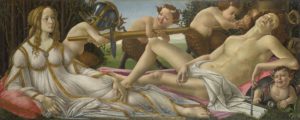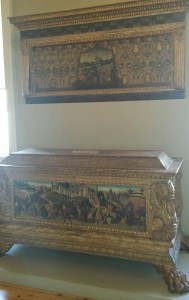 Venus and Mars is a painting in oil and tempera by Sandro Botticelli. Created in the 1480s in Medici Florence it currently hangs in Room 61 of the National Gallery, London. It depicts two Roman gods reclining in a woodland setting, though there is, if you look very closely, a city in the distance.
Venus and Mars is a painting in oil and tempera by Sandro Botticelli. Created in the 1480s in Medici Florence it currently hangs in Room 61 of the National Gallery, London. It depicts two Roman gods reclining in a woodland setting, though there is, if you look very closely, a city in the distance.
As is fairly standard, Venus represents beauty and love and Mars martial valour. So, given that Mars is clearly exhausted after his amorous efforts ( and it’s pretty clear that the couple have just made love ) while Venus is alert and watchful, the painting can be seen as the triumph of love over war. This is fitting as it was painted to celebrate a wedding, possibly of someone associated with the Vespucci family, regular clients of Botticelli, who, it is surmised, commissioned the painting. Their badge includes the wasp – vespa in Italian –  and there is a mini-swarm of wasps about Mars’ head and a wasp’s nest beside him. There is speculation that the model, or inspiration, for Venus was Simonetta Vespucci, famous Florentine beauty of the day. In truth, we don’t know.
and there is a mini-swarm of wasps about Mars’ head and a wasp’s nest beside him. There is speculation that the model, or inspiration, for Venus was Simonetta Vespucci, famous Florentine beauty of the day. In truth, we don’t know.
The painting, which is on a wooden panel, was probably intended to be set into a piece of furniture. Highly decorated wedding chests were popular in 15th century Italy, often with paintings inserted as side panels or back rests. Some good examples can be found in the Courtauld Gallery, Somerset House ( see Courtauld ).
It is a playful picture, not just in the cheeky satyrs who appropriate Mars’ weaponry and clamber in his breastplate, but in the interplay between the two  protagonists. Venus’ expression, if she can be said to have any expression at all, is detached at the very least, possibly even disgruntled. Mars has clearly enjoyed their liaison, but we’re not so sure about the lady.
protagonists. Venus’ expression, if she can be said to have any expression at all, is detached at the very least, possibly even disgruntled. Mars has clearly enjoyed their liaison, but we’re not so sure about the lady.
In part this may also be because she is portrayed fully clothed, albeit in translucent fabric (translucence often featured in Botticelli’s paintings in egg tempera, see Primavera ). As the representative of the bride/new wife, she must, necessarily, be portrayed as chaste. Yet I also wonder if Botticelli is making a point about male self-centredness? He didn’t often paint male nudes and this one is very fine indeed, with the trademark fluid line and the sculptural quality of the flesh, but is there a suggestion that this glorious Mars is just a little bit too full of himself to please his lover?
Some critics think so, while some see it as a warning to men – don’t allow yourself to be ensnared by women, or your manly prowess and strength will be taken from you. One can read the symbolism in this way, but to me the picture is too light and  elegant, and just too playful, to bear such heaviness.
elegant, and just too playful, to bear such heaviness.
Venus was, of course, wife to Vulcan, not Mars, who caught the lovers in the act. So this celebration of sensual pleasure is of an illicit love. Gods get away with such things, I guess, and at least this lady gets a good-looking specimen, not a swan or a shower of gold, but then, she is a goddess herself. Neither Greek and Roman versions of this pantheon were prudish (nor mean with their sexual favours ). In myth, the off-spring of the liaison between Venus and Mars was Cupid, so their love affair on Mount Olympus wasn’t clandestine. The punishment for the two gods’ adultery was to be laughed at by all of the others. A fitting denouement.
If you enjoyed reading this article you might also enjoy The painting formerly known as…. East End Vernacular Picasso 1932: Love, Fame, Tragedy Flower Fanatics


 RSS – Posts
RSS – Posts